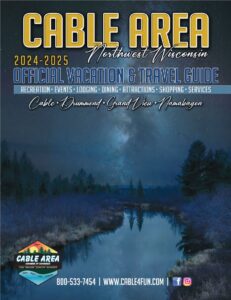Bird Watching & Bird Hotspots in the Cable Area
Spring is a fantastic time to visit the Cable Area! After the snow melts, the area comes alive with beautiful green vegetation and the annual migration and breeding season for hundreds of different species of birds. There are numerous and easily accessible locations to view these marvelous and interesting creatures in their natural habitat. Mother Nature has blessed the area with pristine lakes, large forest coverage, and countless miles of rivers and streams.
What equipment is necessary for birding?
All you need to bring is your binoculars and/or camera, as most birding sites are accessible by foot. However, if you prefer to kayak, canoe, or bike there are many available opportunities for these activities as well. The birding sites listed provide ample birding options with accessibility and fantastic Northwoods scenery.
For additional birding information/guidebooks, stop by Redbery Books or the Cable Natural History Museum! The museum also offers a variety of bird watching events throughout the summer, so checkout their website for more info!
LINKS
Birding Locations
Pacawawong Lake
- Sandhill crane
- Black terns
- Great blue herons
- Green heron
- Trumpeter swans
- Waterfowl
Head of Namakagon River
- Cranes
- Waterfowl
- Wood ducks, pied billed grebe, mallard, hooded mergs, etc.
- Orioles
- Warblers
- Yellow, chestnut-sided, common yellowthroat,
- Bald eagle
- Osprey
Dam Road
- Heron rookery
- Osprey platform
- Warblers
- Thrushes
Barnes
- Connecticut warbler
- Eastern towhee
- Ruffed grouse
- Common snipe
- Thrushes
- Brown thrasher
- Flycatchers
Forest Lodge Nature Trail – offers a variety of loops (from 1 to 5.5 miles), which provide great, leisurely hiking trails and excellent spring birding opportunities. Enjoy various habitats along the trail, which host numerous birds such as assorted warblers, including black-throated blue warblers, thrushes, sparrows, vireos, and bluebirds. During late spring be sure to walk the boardwalk out into the bog to see pink lady-slippers in bloom. The Forest Lodge Nature Trail is located ten miles east of Cable on Garmisch Road, just off of County M, past Lakewoods Resort. Pick up a map for the trail at the chamber!
Namekagon River – Grab your paddle and take a leisurely excursion down the Namekagon River. The river’s best paddling is during the spring and early summer, which is also the best time to view birds. Along the way, you can observe bald eagles, osprey, belted kingfishers, common and hooded mergansers, along with numerous warbler species in the treetops. Easy access points are located at the canoe landings along County Highway M and Telemark Road.
Dam Road – outside of Cable. It may be a rural road, but it offers some wonderful birding opportunities. Located approximately seven miles outside of Cable, off of County Highway M, this road has not only an Osprey viewing platform, but also a great-blue heron rookery, where numerous herons build their nests close together. Follow along a few more miles and you will come up to the head of the Namekagon River, which drains out of Lake Namakagon. In the open lake and wetland area many species of waterfowl and shorebirds can be sighted. In addition, warblers, orioles, vireos, thrushes as well as other species can all be sighted along the shoreline in the trees.
Monthly Bird Sighting Information
January and February
During January and February the best birding locations are typically at bird feeders. Evening grosbeaks, pine grosbeaks, common redpolls, crossbills, and finch species will join local common seed eaters like black capped chickadees, blue jays, cardinals, white and red breasted nuthatches, downy and hairy woodpeckers. During some winter seasons the northern bird species (finches, grosbeaks and redpolls) may be very abundant or on the other hand nowhere to be seen. This sporadic behavior can be partially credited to the seed production of northern conifers, especially spruce trees. Some years the trees will produce more seeds, which supplies the food source for many of the birds, keeping them in their breeding grounds. During lower seed production years the birds will migrate south to our “neck of the woods”.
March
Beginning stages of migration begin during March. In the second half of the month, look for the arrival of robins, grackles and male red-winged blackbirds. The female red-wing blackbirds will not arrive for about a month giving the males time to set up their breeding territories. In addition, bald eagles that wintered in the southern Midwest make their return to the Cable area. Some species, such as great-horned owls, barred owls, crows and ravens will begin breeding during this month.
April
Migration really hits its stride during April. Most waterfowl returns to find any available open water. By seeking out open water, a birder could be in for a real treat as sometimes fifteen species or more could be diving and dabbling. In addition, many songbirds will also return to the Cable area including bluebirds, tree swallows, eastern meadowlarks, thrushes, dark eyed juncos and song sparrows. Other groups of birds including sandhill cranes, killdeer, great blue herons, and many raptor species will also make the journey back to their breeding ground. As soon as the inland lakes open up watch for loons to be designating their territories either that day or the next.
May
May is THE migration month in the north woods. Virtually every breeding bird will either begin to set up their territories or be moving through our region to finish their journey further north. The woods come alive with the various colors of northern orioles, rose-breasted grosbeaks, ruby-throated hummingbirds, warbler species and local favorite the indigo bunting. Shorebirds and marsh birds will join wrens, flycatchers, sparrows and vireos, with almost every day bringing a different species back to the area. Canada geese, mallards, robins, tree swallows, bluebirds, and loons among others have already laid eggs and/or starting raising their young.
June
For anybody interested in learning bird songs, the woods in June would create the perfect learning atmosphere. Nearly every species of bird has returned and begun process of finding a breeding partner. Courtship, the practice of attracting a mate, can visually be seen during this time with many bird species. Some male birds will feed females, while others will do acrobatic aerial displays hoping to catch the attention of a female. Anytime a bird is flying with grass, string or any other material it is solely for the purpose of building its nest. In relation, if you witness a bird carrying insects, worms or other food, it most likely is headed in the direction of its nest to feed its young.
July
The evidence of a successful breeding season becomes clear during July. It is during this month that many adult birds are spending time with young fledglings teaching them to fly and properly sing. Although the summer’s plant growth is very thick, July still serves as a great month to observe all bird species.
August
Ironically, August is the month with more birds in the area than any other month, due to millions of baby birds being born during the previous couple of months, but August is also the hardest month to find birds. Since the breeding season is over most birds do not sing anymore and the woods become, for the most part, quiet. It seems that many species have already left the area to migrate back to their wintering ground, but in reality they are still remaining close to their territory. Some species of shore birds that migrated way up into Canada and the arctic only 2 or 3 short months ago have already left there breeding territory to migrate back to their wintering ground.
September
To the watchful eye, many changes in bird behavior occur as summer begins to fade into autumn. During the previous breeding season competition among species and the defense of territories kept most birds “anti-social.” However, since breeding season is over many bird species will flock up and join forces. For example, numerous species of warblers will flock and travel together, literally filling many trees with active fluttering. Speaking of warblers, distinguishing what type of bird you are looking at can become quite a challenge as the birds have molted their bright colors only to replace them with pale, ordinary feathers, making many species look very similar. Molting takes place among nearly every species of bird. Some birds will replace their feathers with identical colored feathers (blue jays, chickadees, etc.) while others, like warblers, look very different (loons, goldfinches, mergansers).
October
Most migration back to the wintering grounds of birds happens during October. The primary reason for migration is a lack of food source in the breeding grounds. The lack of insects has forced most if not all insect eating birds south, while many seed and berry eaters (sparrows and waxwings) are following behind shortly. Many waterfowl species, which nested further north, have also started following the waterways south.
November and December
As the winter months have taken hold of the north woods, many non-migratory birds brave the cold temperatures. Chickadees, finches, nuthatches and all other seed eating birds are able to keep warm by fluffing their feathers, which traps warm air near their bodies. In addition, whenever they are not in flight, birds shiver to keep warm. Since most, if not all, water has become frozen bald eagles have either migrated south following the open water for their favorite food fish, or stayed in the north to scavenge mostly on road kill deer for the season.
The Cable Area Natural History Museum offers educational classes, trips, & a birding club. They also offer workshops regarding tracks, plant identification, wildlife, and other natural and environmental themes. For questions visit the museum and speak with a naturalist.
What are my chances of viewing majestic birds such as the bald eagle?
A recent spring count of raptor birds, including such species as eagles, hawks, and kestrels showed that Ashland and Bayfield Counties offer an excellent opportunity to see these majestic birds during the spring. In the past few years, a record number of Bald Eagles, Golden Eagles and Northern Goshawks have been spotted, with the number of Bald Eagles increasing each year since 1999.
When is the best time to view raptor migrations?
In the past year, Bald Eagles began coming through the area during the period of late February and early March, with Rough-legged Hawks, Northern Goshawks and Golden Eagles following shortly after. Around the latter weeks of March, Red-tailed Hawks, Sharp-shinned Hawks, a Cooper’s Hawk and American Kestrels were spotted. Once the daylight grows longer and temperatures warm, Osprey and Northern Harriers began migrating to area. Turkey Vultures and Merlins can be viewed in mid-April along with the rarely seen but regular visitors: the Swainson’s Hawk and Broad-winged Hawk. These migrations continue through the end of April and into May.

